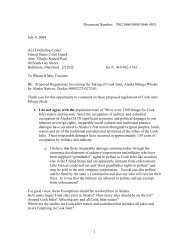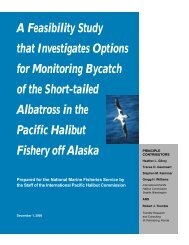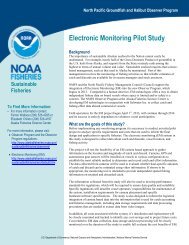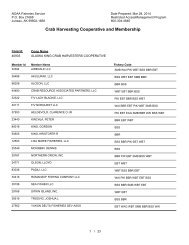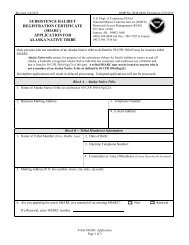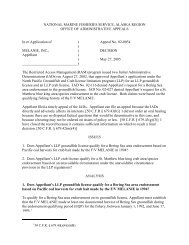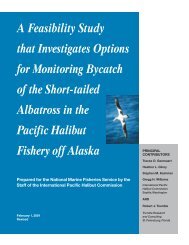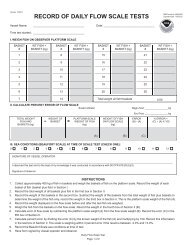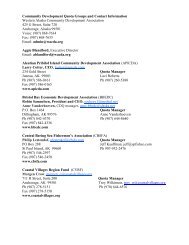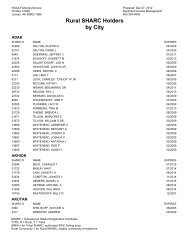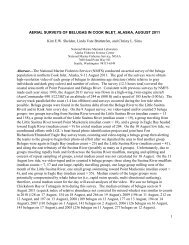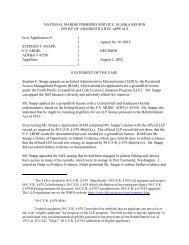Petition to List Lynn Canal Pacific Herring under the Endangered ...
Petition to List Lynn Canal Pacific Herring under the Endangered ...
Petition to List Lynn Canal Pacific Herring under the Endangered ...
You also want an ePaper? Increase the reach of your titles
YUMPU automatically turns print PDFs into web optimized ePapers that Google loves.
each a critical energy level of 3.0 kJ/g in about 87 days. This lipid buffer<br />
provides a nominal 3-month bridge (December–February) <strong>to</strong> <strong>the</strong> beginning of <strong>the</strong><br />
following year’s production cycle but with little margin for error. The possibility<br />
that juveniles also supplement <strong>the</strong>ir energy s<strong>to</strong>res by feeding opportunistically<br />
during <strong>the</strong> winter was examined by Foy and Paul (1999). They found that<br />
although <strong>the</strong>re was evidence for limited feeding, <strong>the</strong> amounts ingested were<br />
apparently insufficient <strong>to</strong> account for winter metabolic demands. On <strong>the</strong> basis of<br />
<strong>the</strong>se empirical observations, we concluded that <strong>the</strong> winter period of plank<strong>to</strong>n<br />
diminishment imposes measurable bioenergetic constraints on <strong>the</strong> survival of<br />
juvenile herring and <strong>the</strong>ir eventual recruitment <strong>to</strong> <strong>the</strong> adult s<strong>to</strong>ck in PWS.<br />
(Cooney et al. 2001).<br />
In addition <strong>to</strong> <strong>the</strong> threat of starvation, changing ocean conditions may cause<br />
herring <strong>to</strong> grow <strong>to</strong>o large for <strong>the</strong> ecosystem <strong>to</strong> support <strong>the</strong>m. Studies in Alaska have<br />
shown that elevated temperatures associated with El Nino can accelerate growth rates <strong>to</strong><br />
<strong>the</strong> point that <strong>the</strong> herring do not have sufficient energy <strong>to</strong> successfully over-winter and<br />
spawn, particularly if food is also in short supply due <strong>to</strong> elevated temperatures (Salazar<br />
and Salazar 2002).<br />
The effects of warming ocean temperatures on <strong>the</strong> closely related Atlantic <strong>Herring</strong><br />
is relevant <strong>to</strong> <strong>Lynn</strong> <strong>Canal</strong> <strong>Herring</strong>. For <strong>the</strong> Norwegian population of Atlantic <strong>Herring</strong>,<br />
Engelhard and Heino (2006) described <strong>the</strong> effects of climate and environmental variables<br />
on reproduction. The researchers determined that higher water temperatures and<br />
associated poor food availability caused herring <strong>to</strong> skip reproduction for that year<br />
(Engelhard and Heino 2006).<br />
The extent <strong>to</strong> which herring may skip reproduction was found <strong>to</strong> be not only<br />
related <strong>to</strong> fish size and condition but also <strong>to</strong> climatic fac<strong>to</strong>rs.<br />
Notably, colder sea temperatures (possibly associated with a negative NAO<br />
index) favoured both adult survival and participation in <strong>the</strong> second spawning<br />
season (Table 3). Prey availability is a possible mechanism for this. The copepod<br />
Calanus finmarchicus, a key species in <strong>the</strong> Norwegian Sea ecosystem, is <strong>the</strong> most<br />
important prey species for adult herring during <strong>the</strong> summer feeding season<br />
(Dalpadado et al. 2000). There is an inverse relationship of C. finmarchicus<br />
abundance with <strong>the</strong> NAO and sea surface temperatures (Fromentin and Planque<br />
1996).<br />
The possibility of contrasting climate effects on juvenile and adult herring has<br />
interesting population implications. Usually, variations in survival early in life far<br />
exceed those in adults, so that <strong>the</strong> relationship of overall s<strong>to</strong>ck abundance with<br />
temperature will still follow that of juveniles (in agreement with Toresen and<br />
Østvedt 2000). Despite this, <strong>the</strong> inverse temperature effect on adult herring<br />
survival and skipped reproduction remains relevant, as it is directly linked <strong>to</strong> <strong>the</strong><br />
58



